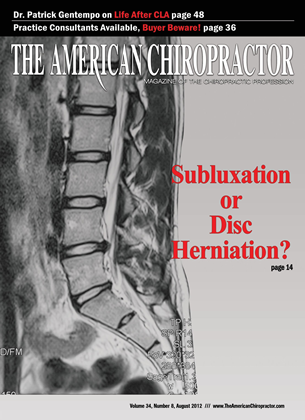History and Presenting Symptoms A 47-year-old female presents with recurrent, sharp pain in her low back. These episodes, which usually resolve within a few days, concern her because they are becoming more frequent. Using a Visual Analog Scale, she describes the usual pain level in her lower back as around 40mm. She doesn't recall any injury to her back, and cannot identify any specific cause for her pain. She states that she just "'tries to relax" for a few days, until the pain resolves. Exam Findings Vitals. This patient is 5'6" tall and she weighs 136 lbs. which is a BMI of 21.9: she is not overweight. Her blood pressure is 124/76 mmllg, with a pulse rate of 76 bpm. She reports that she has never used tobacco products, and averages 2-3 glasses of white wine per week. Postural cxamination.Standing postural evaluation finds basically good alignment throughout her pelvis and spine, except for an accentuated lumbar lordosis. She has a mild bilateral knee valgus and moderate calcaneal eversion, with hyperpronation bilaterally. During gait, both feet demonstrate a tendency to toe-out. An examination of her shoes reveals scuffing and wearing of the lateral aspect of both heels. She states that she usually wears shoes with higher heels for work, and that she has noticed that all her shoes wear out quickly. Chiropractic evaluation.Kemp's testing produces sharp pain localized to the lumbar spine when performed to both sides. Motion palpation identifies functional limitations in extension at the L3/I.4 and L4/I.5 levels, with moderate tenderness and loss of endrange mobility. Neurological tests are negative for nerve root impingement. Imaging A-P and lateral lumbopclvic x-rays in the upright position are taken during relaxed standing.The sacral base angle is 48° and the lumbar lordosis measures 62°, and the lumbar gravity line (from L3) falls anterior to the sacrum. There is evidence of chronic facet imbrication, with sclerosis seen at L3/L4 and L4/L5. There is no discrepancy in femur head or iliac crest heights, and no lateral listing or lateral curvature is noted. Clinical Impression Chronic facet syndrome with lumbar hyperlordosis and increased sacral base angle. This postural stress is being exacerbated by regularly wearing high heels, and by her tendency to overpronate during gait. Treatment Plan Adjustments. Flexion distraction and side posture adjustments for the lower lumbar region were provided as needed, with good response. Stabilization Individually designed stabilizing orthotics were supplied, and she was told to limit her heel height to 1" maximum. She was found to be wearing shoes that were too small for her feet, and was instructed to increase one full size for proper fit. Rehabilitation She was instructed in a daily core strengthening program, to be done at home using elastic exercise tubing. The focus was on activation of her transverse abdominis musculature, for improved spinal stability. Response to Care This patient responded rapidly to her spinal adjustments. She had very little difficulty in adapting to the flexible orthotics, and she reported that the slightly larger shoes with lower heels were much more comfortable. She was consistent w ith her home exercise program, as demonstrated by her exercise log. After six weeks of adjustments (eight visits) and daily home exercises, including wearing the orthotics in properly fitted shoes with lower heels, she was released to a self-directed home stretching program. Discussion This woman's case reinforces the importance of investigating all sources of underlying biomechanical stress, especially when a spinal condition is chronic or recurrent. Shoe-related postural problems are not uncommon, especially in women. Many women don't check their shoe size for many years, and they often wear shoes th at are too small for their feet. Heel height can complicate spinal facet syndromes, resulting in a poor response to chiropractic care. Dr. John J. Danchik, the seventh inductee to the AC A Sports Hall of Fame, is a clinical professor at Tufts University Medical School and formerly chaired the U.S. Olympic Committee s Chiropractic Selection Program. Dr Danchik lectures on current trends in sports chiropractic and rehabilitation.
 View Full Issue
View Full Issue






